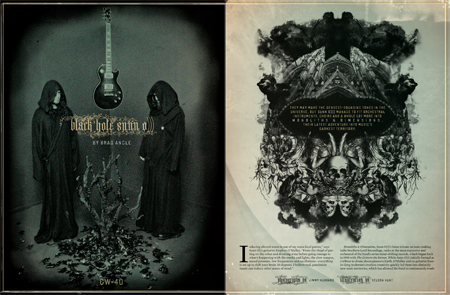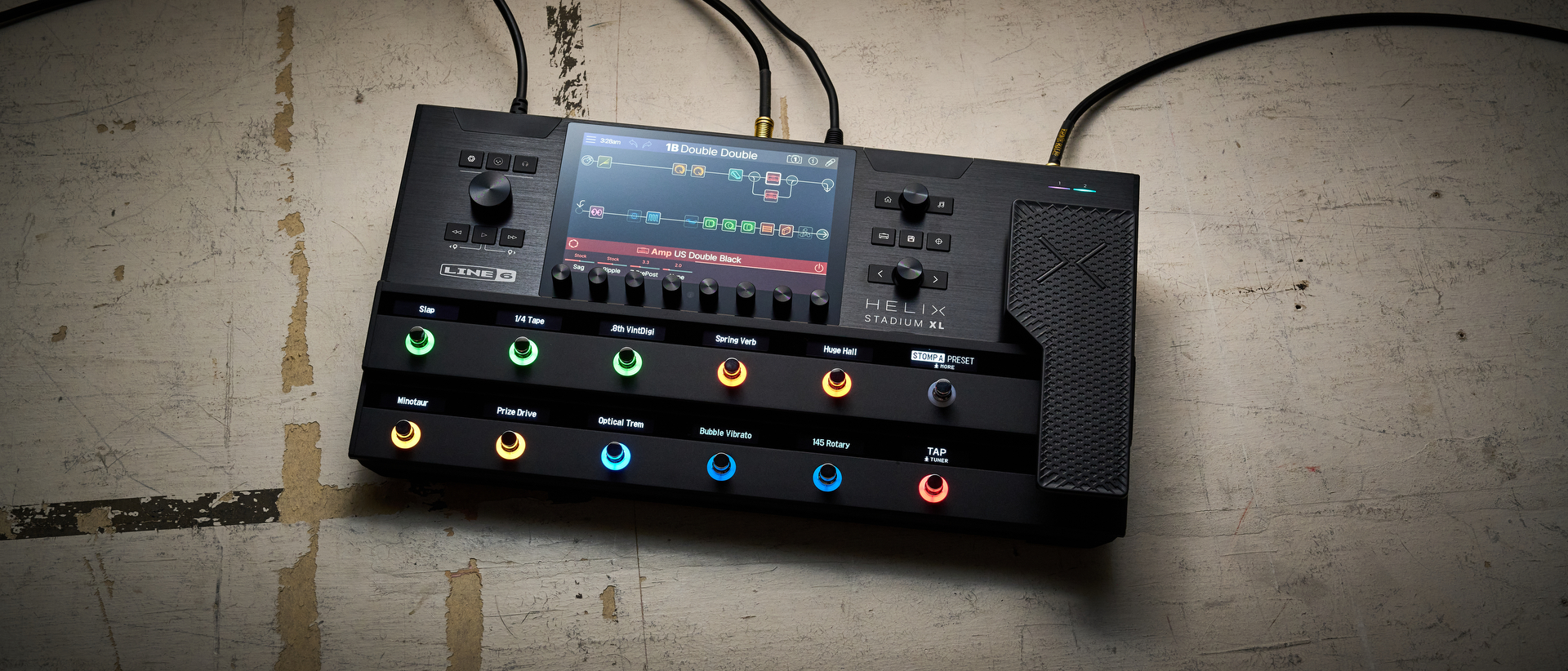Sunn O))): Black Hole Sunn

Originally published in Guitar World, December 2009
They may make the densest-sounding tones in the universe, but Sunn O))) manage to fit orchestral instruments, choirs and a whole lot more into Monoliths & Dimensions, their latest adventure into music’s darkest territory.
Inducing altered states is one of my main focal points,” says Sunn O))) guitarist Stephen O’Malley. “From the ritual of putting on the robes and drinking wine before going onstage to what’s happening with the smoke and lights, the slow tempos, sound pressure, low frequencies and oscillations—everything is set up to shift your brain 20 degrees. I believe real, passionate music can induce other states of mind.”
Monoliths & Dimensions, Sunn O)))’s latest release on taste-making indie Southern Lord Recordings, ranks as the most expansive and orchestral of the band’s seven mind-shifting records, which began back in 1998 with The Grimmrobe Demos. While Sunn O))) initially formed as a tribute to drone/doom pioneers Earth, O’Malley and co-guitarist/bassist Greg Anderson’s restless creativity quickly led them into distinctly new sonic territories, which has allowed the band to continuously evade genre classifications. Attendance at a Sunn O))) show proves the point: hesher stoners, indie hipsters, bookish intellectuals and bizarre artists all gather before Sunn O)))’s waves of sublime subsonics and occult theatrics. To aid in their sonic expansion, over the years Sunn O))) have enlisted a veritable who’s who of cult-star musicians, from black metallers Xasthur and Leviathan to eclectic Japanese rockers Boris to noise pioneers John Wiese and Merzbow.
Sunn O)))’s artistic tides keep shifting, but one thing hasn’t changed in the past 10 years: the core of the group’s sound is still firmly rooted in the classic tube amps after which they’re named, the Sunn Model-T.
“At first we got into them because they were inexpensive,” O’Malley says. “For $300 you could go to a pawn shop and get a 100-watt tube amp. The climate around Sunn amps has changed over the years, and now they’re like $1,500. But all that is secondary. Sunn amps are the engine for what we do.”
With no drummer in the band, Sunn O)))’s sound is truly driven by their Model-Ts. As such, freed of the need to play to a strict meter (to say nothing of having to regulate their volume so the drums could even be heard), O’Malley and Anderson can explore the outer boundaries of volume and deep tonality, which, in turn, allows the guitarists to transcend the confines of traditional metal. “I see Sunn O))) as a kind of fusion band,” Anderson says. “We’re fusing different styles and concepts together. There’s definitely a metal core to what we’re doing, but there’s also experimental, classical and jazz influences.”
All the latest guitar news, interviews, lessons, reviews, deals and more, direct to your inbox!
These influences are on display on Monoliths & Dimensions. To help augment Sunn O)))’s minimalist metal, the duo recruited a host of guest musicians to provide choral and orchestral elements, such as upright bass, French and English horns, harp, flute, piano, and brass, reed and string ensembles. The contributors included composer Eyvind Kang, Persian vocal specialist Jessika Kenney, a Viennese woman’s choir, Sun Ra trombonist Julian Priester and horn player Stuart Dempster. Sunn O))) brought a few old friends into the mix as well, including Australian guitarist Oren Ambarchi, Earth mainman Dylan Carlson and Mayhem vocalist Attila Csihar, all of whom added their distinct metal stylings to the project. The result is a sonically rich album that Sunn O))) collectively describe as “a practice in density, gravity and momentum.”
O’Malley and Anderson explain to Guitar World how two metalhead riffers harnessed spectral composition theories and created the mammoth Monoliths & Dimensions.
GWMonoliths & Dimensions marks Sunn O)))’s 10th anniversary. When you first started, did you ever expect you’d be around this long?
GREG ANDERSON When we started our expectations were very minimal. This was just an excuse for Stephen [O’Malley] and I to keep playing music together. In the mid Nineties, we played together in Thorr’s Hammer, but that dissolved when we moved to different cities. A couple years later, Stephen and I ended up in L.A., and it was like, “Why don’t you and I get together in a room with as many amps as possible and play riffs?” It was that simple.
GW Since then your compositions have progressed to where you now use orchestrations quite heavily. What led you down that path?
ANDERSON We really wanted to add acoustic strings, brass and a choir to this album. We just had to figure out how. [Engineer] Randall [Dunn] suggested working with Eyvind Kang, because he was a great musician, composer and arranger that also had classical music contacts in the Seattle area. The loose plan was that Stephen and I would record the core tracks and play them for Eyvind, who would figure out how to expand all of the tones.
STEPHEN O’MALLEY Eyvind was critical to this album, as was [multi-instrumentalist] Steve Moore. They were the ambassadors to and translators for the acoustic instrument players. They brought horn players like Julian Priester and Stuart Dempster into the project. We couldn’t just get regular arrangers or conductors. It took a certain philosophy of sonics and shared inspirational points based on certain spectral-composition composers.
GW Can you give an example of these spectral composition theories?
O’MALLEY Eyvind, Greg and I had to find a common place so we could communicate our ideas. Eyvind referenced [French composer] Gérard Grisey as someone we should look at. A lot of Grisey’s compositions create a kind of illusion: he’ll use a symphony to create music that sounds like natural, field-recorded sounds. There’s a bit of that with Sunn O)))’s guitar levels, feedback and overtones, but it’s coming from a guitar, [Pro Co] Rat pedal and Sunn fullstack. Another reference point was a Romanian composer called [Iancu] Dumitrescu, who did these brutal pieces for double bass in a series called Medium.
GW What led you to recruit a Viennese woman’s choir?
ANDERSON Eyvind’s wife, Jessika, is a classically trained vocalist and her focus is Persian singing, which is amazing because she’s a punk rock chick and comes from the same scene as us. She’s also involved with this women’s choir in Vienna that does experimental music, and that’s how the collaboration began.
GW Attila adds some intense vocals to “Aghartha.” How was working with him this time different than on [2005’s] Black One album?
O’MALLEY This is the first record where he was in the studio with us from the beginning. He’s an inspiring dude with a lot of bizarre interests. For his lyrical concepts, he’d respond to these musical pieces and personify them as some sort of exploration into the tunnels of the earth, which is literally what happened on “Aghartha.”
GW “Aghartha” also has some wild found sounds on it, like things that sound like ships creaking in the water.
O’MALLEY What you call the “creaking ship” sound was someone slowly raking along the double-bass strings. That’s basically our homage to Dumitrescu. The water sounds were recorded by one of the engineers, Mel Detmer. She has these hydrophones, or underwater microphones, which she used to make recordings from the Puget Sound, off the Seattle coast.
GW How much of Sunn’s songwriting process is built around improvisation?
O’MALLEY Improvisation is at the root of our writing. The track “Big Church” is one of the more compositionally experimental tracks on the record, but the initial versions were improvised around a few chord clusters. It was tricky and it took the longest to figure out, but for me it’s the most rewarding track on the album.
GW I think it’s implicit that Sunn amps are integral to your sound, but could you talk a little bit about why?
O’MALLEY For guitar, which is what the band is about, the Seventies Sunn Model-T is key. It’s a pretty simple amp that I compare to a Chevy muscle car from the Seventies: you can open it right up and work on it. It’s not like opening up a Line 6 and finding an iPhone inside. [laughs] That feature has allowed us to experiment with different preamp tubes and really get to know the amps. It’s shocking how much you can mod out your amp by only changing the preamp tubes. You can get an incredible range of levels and harmonic overtones.
GW You’re playing music that requires high-output amps and creates subsonic frequencies. What challenges does that present as far as the recording setup?
ANDERSON It is a challenge to record. The main thing with this record was to make it sound vibrant and live. All of the heavy stuff was tracked at full volume. Re-amping is something we learned a few years ago on Black One. Since we have no drummer and no meter, it’s really frustrating to overdub. So what we do is track everything clean, and afterward we can send those clean tracks back through the amps to create the sound we want.
GW What are your levels when you play live?
O’MALLEY They’re not wide open, at least not for me. I’m usually around half on the master volume and the preamp, but you get a lot of power and volume out of that. Our rider says we get up to 125 decibels. This is true, except that any one stack isn’t going to be that high. But collectively we definitely get up there.
GW Sunn O)))’s approach has always struck me as being rather alchemical, in that you’re refining and reducing sounds to a pure level, which then produces a new intense power.
ANDERSON That’s a good point that no one has brought up before. That’s what it’s really about, but I’ve probably only been aware of it subconsciously. Recently, Stephen and I have been doing these duo shows based on that idea. We want to show people the core in hopes that they’ll understand what is at the root of Monoliths & Dimensions’ expansion. Sunn O))) would not exist without its core. We’re very mindful of keeping that in tact.
